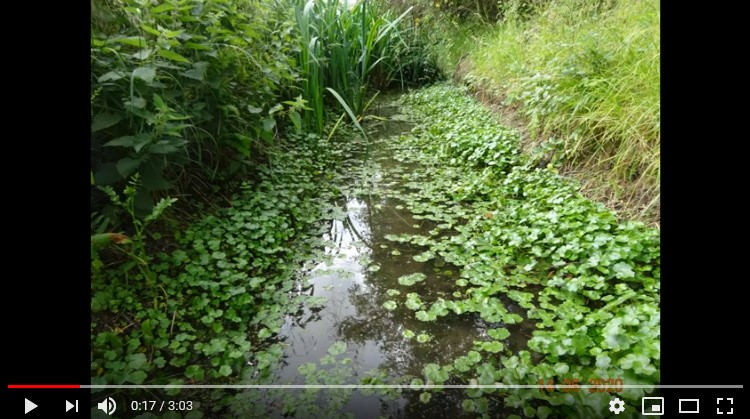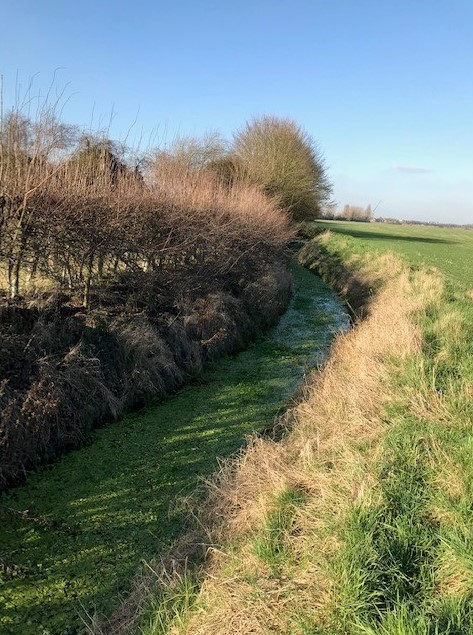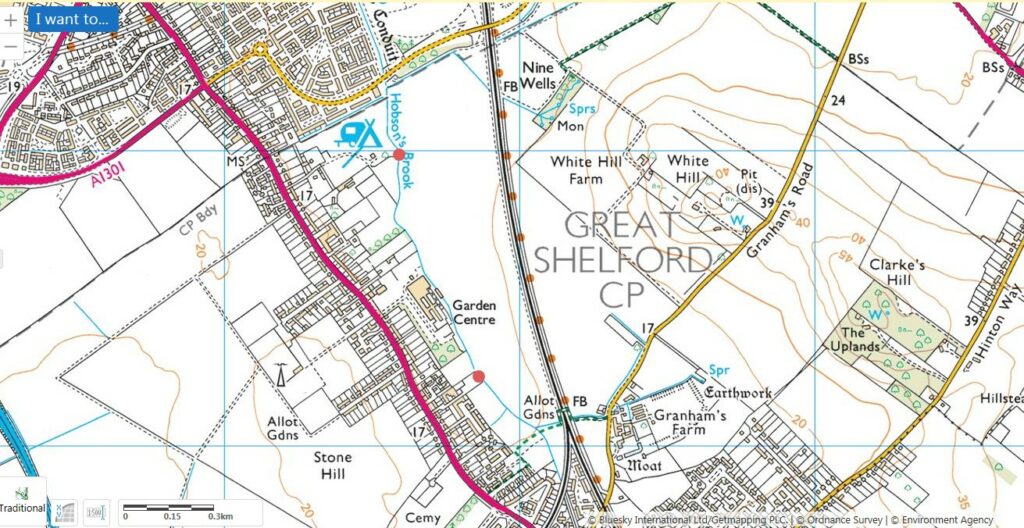 The email extracts below give the flavour of how persistent dedicated volunteers, with support from agencies and councils can take on the eradication the invasive weed, Floating Pennywort. This is the (ongoing) story of the fight.
The email extracts below give the flavour of how persistent dedicated volunteers, with support from agencies and councils can take on the eradication the invasive weed, Floating Pennywort. This is the (ongoing) story of the fight.
We had previously suceessfully eradicated Floating Pennywort from the Upper Cam (see blog posts from 2017-19) so we were very concerned when we were notified on 11 March 2020 by the Environment Agency that they’d received a new report of Floating Pennywort on Shelford Stream; a small chalk stream watercourse that flows into Hobsons Conduit, then the Cambridge Botanic Garden and the Cam. ….
23/6/20
From Mike: A minor milestone was reached today, all sections of the affected length have had plants on their bank sides gouged out at least once with a rake or by hand, and plants in the bed silt removed. It is though a bit like painting the Forth Road Bridge…
A working party is coming in soon to repeat the clearance of the bank sides and bed…
I took some videos of the stolons in the bank. A rough and ready video compilation is here (amateurish, sorry): https://youtu.be/DPc6Zn1CdtQ
The major challenge is the address the network of stolons that have grown into and embedded themselves in the silt in the bed of the stream but more significantly in the bank sides. The sides are now drying out as the water levels have dropped to a little as 10cm (I assume that the springhead of this Chalk stream has dried up) but we must accept that some stolons hidden within the silt will survive. My fear is that these stolons will initiate a fresh wave of growth next spring when the water levels rise again….
1/6/20
Now that this stream has been deemed to be a ‘Chalk stream’, with a springhead at Granham’s Farm (Roman Camp), and possibly by two more springs, to me personally it has become a more interesting watercourse, and it does actually look pretty good at the moment along its more open stretches with Starwort, Fool’s Watercress, reeds, irises, frogs, tadpoles, shoals of Minnows (and 1cm fry), and Water Voles easily found at the moment. However, at about halfway along the stream at the culvert the water level was only 5cm today and is continuing to drop. It will soon become a pond in its upper part.
18/5/20
With chest waders, skimming the Pennywort with a rake is the easy part, even where it is growing on the bank above the dropping water line. The hard job is riffling the silt to dislodge and then rake stolons which are embedded and difficult to budge. I chose the most difficult section this morning, 78m done, work rate 10m per 21 minutes. Pairing up again later this week or so, to double work rate.
4/5/20
The three man SCDC team did a great job finishing the bulk removal today and started on the removal of small strands
28/4/20
Rob and I did a good stretch of debaulking yesterday and there’s about 80m still to do. The Pennywort growth habit has changed from flat to raised especially over the past fortnight and has the appearance of summer growth now though not like peak growth yet. ..
Then, this morning, Pat rang me to offer three of his drainage team for two days next week, 4th and 5th May. The team leader will contact me to discuss how to get there and what to do. I want them to finish the debaulking, clear overhanging brambles as they wade, and begin the netting and raking through the silt to scrape out the Pennywort. ..
We are all trying to minimise the need to use glyphosate. At least now we don’t have the scenario of bulk spraying followed by rotting down, bacterial activity and deoxygenation.
19/4/20
An update: – some more small waterways upstream now checked and no Pennywort found.
3/4/20
I am pleased to say that our application for £2016 from SCDC’s wildlife Enhancement fund has been approved … I think that it will all be spent, and more.
26/3/20
Contractors have stopped working for now [due to Covid Lockdown] I know it’s not ideal as the Pennywort will continue to grow, but maybe if everything goes to plan they can drop back onto it.
23/3/20
From Mike: Today, started at top and sweep-netted 40m until a culvert. That was enough to time the stretch and it took 30 minutes. When you are actually wading the overhanging brambles are irritating and slow you down as they get in clothing and catch on your head…
At least the Cornonvirus’ new rules tonight allows a form of exercise every day. As I live only two minutes drive from the site and it is deserted there I feel I can contribute without breaking the rules.
19/3/20
From Mike: The Contractors team removed Pennywort along 400m of the stream. Of the 1.1km total length, about 300m has no, weak, or sparse growth so they did one-half of the dense mats. They have a good system, two chromes taking out the bulk followed, using waders in the stream, by scooping with a flat head on a pole, and finishing with a sweeping net
12/3/20
From James: Hi Howard I have a contractor who charges £[..] a day for a four man team to clear Pennywort, it might be cheaper as they wouldn’t be using boats, chemical or tools to debaulk it. They are dry suit equipped so could get in and tackle the really difficult areas. I expect they could do a lot in one day.
From Howard: I have been talking with our vice-chair about this. We would both be happy for Hobsons Conduit Trust to give some financial support to this
from Anne: Excellent you were able to get out and check Mike. As the saying goes “Houston, we have a problem”….
Lets get the boom in, then see if we can arrange a collaborative effort to get this cleared in March/ April, before the FP starts bulking up….
If we can’t use machinery because of crop damage or availability of kit from the farmer, we may need to get in contractors to do it manually with rakes
Re paying for it. we have a little of the CVF pennywort funding left from the upper Cam project and if the EA and the riparian owners would each match what we put in, I would be prepared recommend to the CVF committee that we should put it in the pot. Maybe Hobsons Trust would be able to help too?
11/3/20 21:03
From Mike: I can confirm there is Floating Pennywort in the ditch.
After reading your email I walked the ditch which joins Hobson’s Brook just south of Addenbrooke’s Road, goes past Scotsdales and crosses the railway and Granhams Road. The ditch isn’t Hobson’s Brook proper although it is called that on some maps but I don’t have a name for the ditch. I could only check from Addenbrooke’s Road to the end of the camping site so I will check the ditch in its entirety to east of Granham’s Road tomorrow. …
11/3/20 16:22
From Anne: That looks absolutely horrific. If that really is floating pennywort (rather than brooklime or one of the watercresses), its essential its dealt with asap before it escapes and contaminates the rest of Hobsons brook and then the Cam. We’ll try to get out and have a look asap (Mike lives quite close)
The farm land on the east side is owned by St Johns College, and the land agent for it is John Wootton of Savills….
11/3/20 15:37
From James at the Environment agency: Hi Anne and Mike I managed to inspect Granchester pool on Sunday, it was a welcome rest break and its all clear, unfortunately we have recently been told of Pennywort in Hobson’s Brook [aka Shelford Stream], Please see map below, I think its about 900m long, the good news is it is being held in place by a large Norfolk reed bed just by the caravan site, hopefully it will not feed the Cam. Do you know who the farmer is and how good access is? I have not seen it in the flesh but it looks like there is a crop on the field, which may mean machine clearance is difficult.


